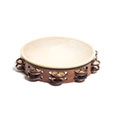The tambourine is one of the most common accessory percussion instruments and is used in many familiar musical styles, including rock, pop, and classical genres. Derived from jingle-bearing frame drums from around the world, such as the Brazilian pandeiro and the Egyptian riq, there are many approaches to playing the instrument. Even within the concert percussion world, performers use numerous playing techniques. However, many non-percussionist directors and young players may be unaware of the fundamentals of tambourine tone production, resulting in performances with incorrect technique and poor sound quality.
Instrument Parts and Selection
The most common concert tambourines have a diameter of ten inches, two rows of jingles, and either a calfskin or synthetic head. While calfskin heads remain a traditional choice of some professionals, synthetic heads are significantly more durable, require less maintenance, and are not affected by weather and humidity, making them ideal for school groups. A headless tambourine with a plastic shell is typically a handheld pop/rock instrument or mounted on a stand; it should not be used for concert playing.
Most tambourine shells are made of solid wood, although composite ply shells are available on less expensive models. In addition to jingle slots, each shell features a holding area without jingles so the player can grasp the shell. There is a hole in this area for mounting the tambourine on a cymbal stand – it is not intended for use while holding the instrument in the player’s hand.
The jingles are made of three primary metals: silver (high pitch), copper (medium pitch), and bronze (low pitch). In addition to the metal used to construct them, the physical texture of the jingles has a significant effect on the instrument’s tone. Smooth, nickel-plated discs like German silver jingles provide the brightest jingle sound and greatest dynamic projection. Corrugated or fluted discs are heavier and duller sounding due to crimping, over hammering, and sometimes even excessive heating. These jingles are best used for delicate, quiet, and articulate playing. Most manufacturers offer tambourines with mixed jingle combinations, and picking the appropriate jingle sounds for your musical situation is an important consideration. If your program only has one tambourine, it is best to consider an instrument with a combination of bright and dark jingles that will complement most performance settings.
Instrument Grip and Playing Positions
To execute all tambourine techniques with ease it is crucial to hold the instrument properly. With the tambourine head facing up, locate the holding area of the shell. Place the bottom of the shell in your non-dominant hand where the fingers meet the palm.
.jpg)
Wrap fingers around the bottom of the shell,
.jpg)
and place the thumb above the shell on the drumhead. Do not put any fingers through the mounting hole on the side of the shell.
.jpg)
In addition to holding the instrument, proper tambourine playing requires a designated playing position, rest position, and a method to transition from one position to another.
Playing Position
Using the grip described above, lift the instrument so the forearm is parallel to the ground and then rotate the tambourine with your wrist so that it rests at a 45-degree angle.

The angle of the tambourine affects how much excess jingling there is. Tilting the tambourine 45 degrees allows the jingles to quickly come to a rest after the drum has been activated, which eliminates any unwanted sounds from extraneous vibrations. Holding the tambourine perpendicular to the floor will produce the most extraneous sound. An instrument that is parallel to the floor allows a constricted vibration of the jingles, but there will still be some excess sound.
Rest Position
Because the tambourine’s jingles are designed to move freely, the tambourine is one of the most challenging instruments to keep quiet when not in use. A resting position that allows the tambourine to be picked up as quietly as possible is essential. As with all accessory percussion instruments, the performer needs a trap table, music stand with a towel, or a padded surface on which to rest the tambourine. Placing the tambourine on a trap table with the holding area facing the player and the drumhead facing up will allow the player to smoothly and quietly pick up the instrument.

Transitioning Between Positions
The player must also consider how to move silently from rest position to playing position. Using the non-dominant hand, grip the tambourine as described above and lift the instrument while keeping it parallel to the ground. This will help to keep the jingles flat and silent when preparing to play. To avoid extraneous jingling noise, do not switch the instrument from hand to hand.

When the tambourine is near chest level, the instrument can be shifted to the 45-degree playing position. When returning the instrument to the table, ensure that the tambourine is flat so that there are no extraneous sounds from the shell striking the table multiple times.
Playing Zones and Techniques
With the instrument in playing position, use the dominant hand to strike the tambourine. Do not move the drum to strike a hand or another surface. The ideal playing zone varies from the center of the tambourine head to directly over a set of jingles, depending on the desired timbre. The area toward the center is best for mezzo forte and louder passages because of the significant volume produced by a combination of head and jingle sounds. Striking on or near the rim provides more precise jingle sounds that are best for delicate, articulate passages at lower volumes.
General Playing
For moderately-soft to moderately-loud passages, cluster the thumb and fingers of the dominant hand together and strike the drumhead between the center and edge, directly across from the non-dominant hand holding the instrument in playing position.

Loud Passages
To adjust for louder volumes and accented notes, form the hand into a loose fist and strike the drum in the center of the head with the flat of the knuckles as if knocking on a door.

Soft Passages
Use the thumb and fingers to strike the instrument at the edge over a set of jingles. For the softest, most delicate effects, strike on the rim with only one finger.

To increase the dynamic level, strike the instrument with more fingers. To add head sound to the overall timbre, strike the drumhead closer to the center.
Techniques for Rapid
Rhythmic Passages
Many composers write rhythmically-dense tambourine passages that are difficult, if not impossible, to execute with only one hand striking the tambourine. The following methods allow the player to execute quick rhythmic passages at varying dynamic levels.
Loud Rapid Passages (Knee-Fist Method)
This advanced method uses the player’s dominant hand and knee to execute quick rhythms. Place one foot on a chair, snare drum case, or lower tripod of a drum stand. Turn the tambourine upside down (or have a second tambourine already resting upside down) and hold it so that the center of the head is a few inches above the propped-up knee. Make a loose fist as if initiating a powerful single stroke with the dominant hand above the center of the head.

Strike the inside of the drum head with the fist, and then use the non-dominant hand to move the entire instrument and strike the outside of the batter head against the knee. For a consistent sound, ensure that the hand and knee strike the head in the same location. The fist is usually stronger, which can be used for emphasis in accented patterns.
Soft Rapid Passages
Similar to the technique for loud rapid passages, place one foot on a chair, snare drum case, or lower tripod of a drum stand. Lay the tambourine on the propped-up thigh with the head facing up. Rest forearms or palms on the drumhead to control the sound by varying the pressure and how much of the head is covered or muted. Using the fingertips, strike the rim over top of a set of jingles closest to the knee . Make sure that hands are positioned symmetrically for an even sound.

As with soft single strokes, adjust dynamic levels by adding or subtracting the number of fingers used by each hand. If searching for an alternative to resting the instrument on a leg, lay the tambourine on a trap table cushioned with a towel or padding. Play near the rim with the fingertips of both hands over the top of a set of jingles. Control the sound of the instrument by varying the pressure and muffling of the head with wrists and forearms as described above.

Stand-Mount Method
This method is primarily used when the composer specifically requests the use of sticks or mallets. Using the mounting hole in the tambourine, attach the tambourine to a cymbal stand. Use extra cymbal felts if necessary and tighten down the cymbal wing nut to prevent the tambourine from moving or rotating excessively.
.jpg)
Extra care must be taken when using mallets or sticks to avoid breaking the head. Consider using a mountable plastic pop/rock tambourine to spare the high-quality concert tambourine from being struck with sticks.
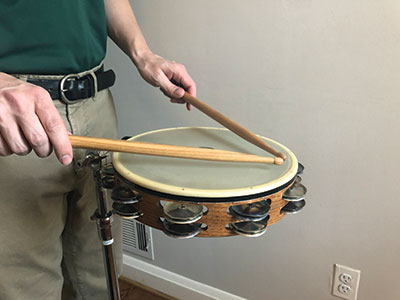
Tambourine Rolls
Tambourine rolls are one of the most frequently misunderstood tambourine techniques. Confusion occurs when determining how to execute the roll itself, attempting to create a sustained sound (as opposed to a rapid succession of rhythmic attacks), and accurately starting and stopping the roll. The first decision facing a performer is choosing between the shake and friction (thumb/finger) rolls.
Shake Rolls
Shake rolls are best for louder dynamic levels and longer rolls. When initiating a shake roll, hold the tambourine in the standard playing position described above. Begin the roll by striking the instrument with your dominant hand – much like a wind player articulating the beginning of a sustained note with their tongue. The player can envision ‘pushing’ the tambourine into the shake roll with this initial attack. Using the wrist and forearm, rotate the tambourine from left to right as if turning a doorknob back-and-forth.
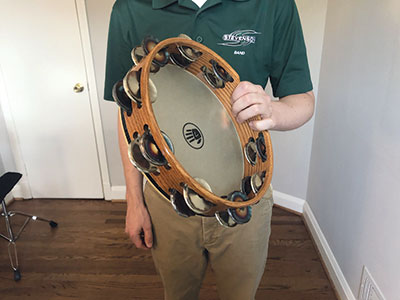
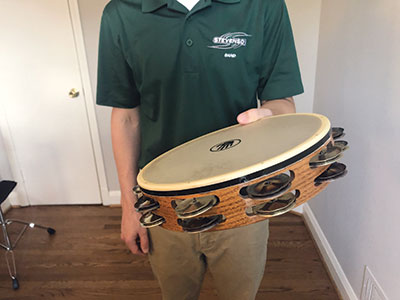
To become comfortable and produce a smooth, sustained sound, practice this motion slowly and then speed up to ensure proper execution. Just as the roll began with a clean attack, it must conclude with an attack to define the roll duration. When striking the drum to release the roll, immediately return the tambourine to the standard 45-degree playing position to ensure the jingles stop moving.
Friction Rolls
Friction (thumb and finger) rolls are best used for softer dynamics and shorter rolls. To achieve this technique, the player will skip the thumb or middle finger around the perimeter of the head. The player should hold the tambourine in playing position, with the finger or thumb of the dominant hand on the edge of the tambourine close to the holding area.
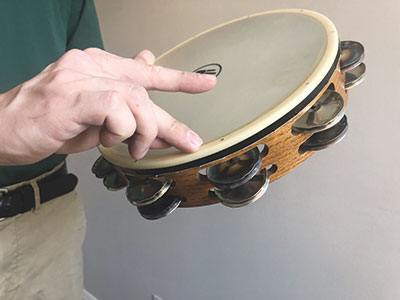
.jpg)
Friction rolls performed by middle finger (above) and thumb (below).
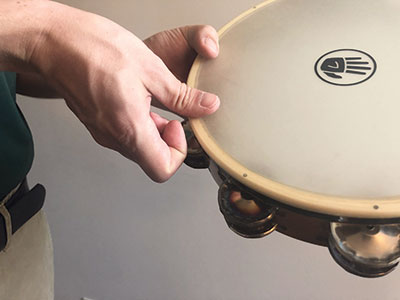
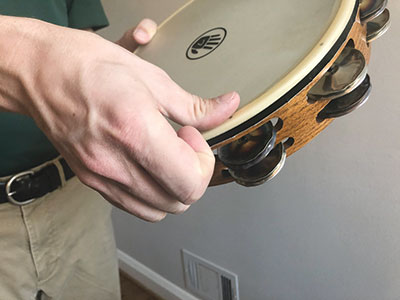
The fleshy part of the thumb or finger exerts a light rubbing motion around the rim of the head, causing the jingles to vibrate. Proper execution requires the head to be tacky. Many players apply beeswax or bass bow rosin to the head, while others wear a rubber thumb or finger cover.
For a soft release, drop your pointer finger into the head as you lift your friction thumb/finger away from the instrument.
For an accented release, you can drop the heel of your hand onto the drumhead instead of your finger.
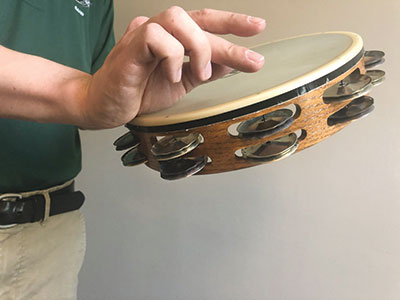
Visual Dynamics
Playing the tambourine is inherently theatrical due to the visual elements produced by the techniques described above – especially when considering dynamic levels. In addition to striking the drum with more force to produce louder sounds, holding the instrument near the player’s waist and raising it higher in the air as the volume increases can emphasize a crescendo. This allows the conductor and audience to view the instrument as the passage becomes louder. The same concept can apply to a decrescendo, only the player will start with the tambourine higher in the air and then lower it as the passage becomes softer. The tambourine can be held near the player’s eye level when executing louder passages and closer to the stomach level for quieter passages to enhance dynamic levels visually.
Additional Considerations
High-quality concert tambourines require proper care and maintenance. It is essential to take precautions to make sure that the instrument is always in good working order. The tambourine should be stored in a protective case or bag and should not have heavy items stacked on it. Periodically inspect the head and shell to ensure there are no cracks, pulls, or head tears.
